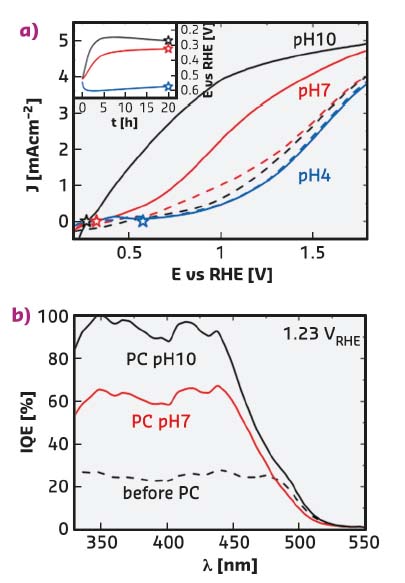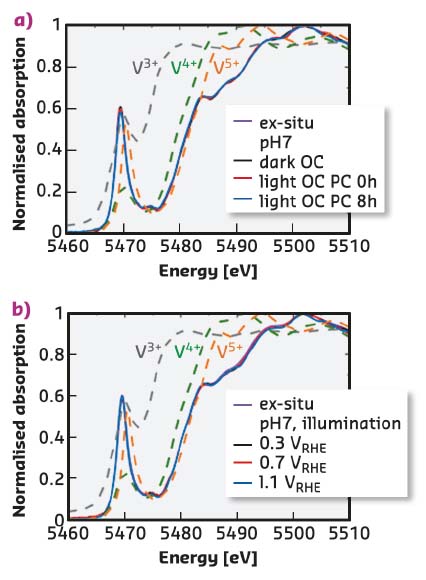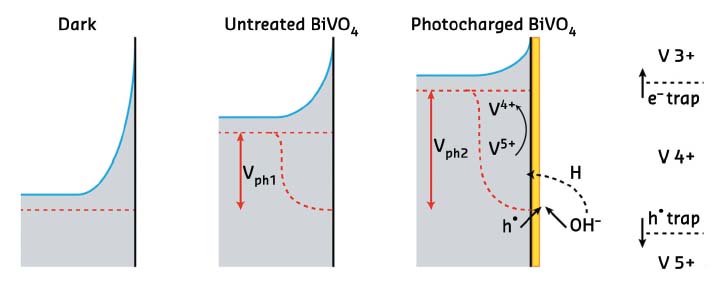- Home
- Users & Science
- Scientific Documentation
- ESRF Highlights
- ESRF Highlights 2017
- Electronic structure, magnetism and dynamics
- Photoelectrochemical cell efficiency increases by photocharging BiVO4 photoanodes
Photoelectrochemical cell efficiency increases by photocharging BiVO4 photoanodes
Solar water splitting by a photoelectrochemical cell has potential for the sustainable production of hydrogen. The photocharging treatment of a BiVO4 photoanode dramatically improves a cell's efficiency. Experiments at BM26 (DUBBLE) helped reveal that photocharging involves the surface of the electrode.
Photoelectrochemical (PEC) water splitting is an attractive route to capture, convert and store the energy from the sun in the form of chemical bonds. This approach allows for the sustainable production of solar fuels (typically H2), and thereby addresses the challenges of new energy technologies needed for a renewable and carbon-free economy.
Solar water splitting is most efficiently performed using semiconducting photoelectrodes, which directly utilise photo-generated charge carriers to drive the water oxidation and reduction half-reactions at the corresponding solid/liquid interfaces. Metal oxides have been heavily studied as a class of photoelectrode materials for PEC devices due to their low cost and stable operation. Specifically, bismuth vanadate (BiVO4) has proven to demonstrate impressive activity as a photoanode material. However, due to its inherent bulk- and surface-related limitations, complex strategies such as doping or co-catalysts are typically necessary for BiVO4 to reach high yields for O2 production.
Herein, photocharging has been investigated, which is a simple and novel treatment that can dramatically improve the water splitting capabilities of BiVO4 [1]. It was demonstrated that illumination combined with alkaline conditions alters the chemistry at the semiconductor-electrolyte interface to form a BiVO4 surface with superior activity for the oxygen evolution reaction (see Figure 99).
 |
|
Fig. 99: a) Current vs. potential curves of BiVO4 in PBA buffer at pH 4, 7 and 10; a stable tenth anodic scan is shown in each case. Dashed curves are untreated films, solid curves are photocharged films. b) Internal quantum efficiency measurements of 200 nm BiVO4 in PBA buffer at pH 7 and 10 before and after photocharging (PC) collected at 1.23 V vs. RHE (reversible hydrogen electrode, a reference electrode). |
The improvement in performance using the photocharging technique is so dramatic that both bulk and surface phenomena could be responsible for this enhancement. To investigate any possible impact of the photocharging treatment on the chemical and structural properties of bulk BiVO4, specifically to identify any changes in the average bulk oxidation state of vanadium and in the local environment, an in situ XAS study at beamline BM26 was carried out (Figure 100). This provided critical insight into photocharging that allowed a model to be built to understand the improved behaviour of the photoelectrodes.
 |
|
Fig. 100: Vanadium K-edge XAS spectra collected (a) ex situ and in situ while photocharging (PC) under open circuit (OC) conditions, in the dark and under illumination (b) ex situ and under illumination and with applied bias potential. |
As neither the photocharging treatment nor applying bias potential (0.3 – 1.1 VRHE) alters the structure/chemistry of the bulk of BiVO4 films it was concluded that the films do not display any signatures of changes in the average bulk vanadium oxidation state, despite significantly different PEC properties. The XAS experiments provided evidence that bulk vanadium in the films always remains in the +5 oxidation state. Complimentary data using XPS and electrochemical impedance spectroscopy (EIS) revealed that the surface becomes slightly reduced, resulting in vanadium in a slightly lower oxidation state, which leads to a significantly higher rate of catalysis, due to either lower surface recombination or enhanced water oxidation kinetics (Figure 101).
 |
|
Fig. 101: Energy band diagrams of BiVO4 in the dark and under illumination before and after the photocharging treatment, including the simplified photocharging mechanism model. |
In conclusion, photocharging enhances the efficiency of BiVO4 through surface reaction pathways at the semiconductor-liquid junction. It is directly correlated with the electrochemical environment in which the treatment is applied. The photocharging technique can potentially be applied to other photo-electrode materials.
Principal publication and authors
Near-complete suppression of surface losses and total internal quantum efficiency in BiVO4 photoanodes, B.J. Trześniewski (a), I.A. Digdaya (a), T. Nagaki (a), S. Ravishankar (b), I. Herraiz-Cardona (b), D.A. Vermaas (a), A. Longo (c,d), S. Gimenez (b) and W.A. Smith (a), Energy Environ. Sci. 10, 1517-1529 (2017); doi: 10.1039/c6ee03677e.
(a) Materials for Energy Conversion and Storage (MECS), Delft University of Technology, Delft (The Netherlands)
(b) Institute of Advanced Materials (INAM), Universitat Jaume I, Castelló de la Plana (Spain)
(c) Netherlands Organization for Scientific Research (NWO), ESRF, Grenoble (France)
(d) ISMN-CNR, UOS Palermo, Palermo (Italy)
References
[1] B.J. Trześniewski and W.A. Smith, J. Mater. Chem. A 4, 2919-2926 (2016).



